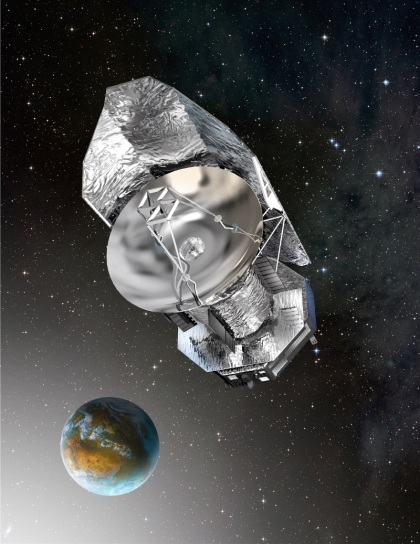Press Release 5/2013 - April 30, 2013
Herschel completes its scientific operational phase
In more than three and a half years, ESA's mission Herschel allowed for new insights into our solar system.
The Herschel Space Observatory, one of the cornerstone missions of the European Space Agency (ESA) with participation from NASA, has exhausted its supply of liquid helium. Yesterday's communication with the ground station revealed a clear rise in temperature measured from all instruments - a sure sign, that there is no longer any coolant left. The scientific operational phase of the mission has thus come to an end. In the past more than three and a half years since the launch, Herschel has not only investigated distant galaxies and stars. The mission has also provided new and surprising insights into our solar system. For example, with Hartley 2 researchers from the Max-Planck-Institute for Solar System Research were able to identify a comet with water strongly resembling that on Earth. The MPS leads Herschel's observational campaign of the solar system.
"In order to detect molecules such as water, oxygen, and carbonoxide in the atmospheres of planets and moons as well as in the vicinity of comets, taking a look at the far infrared signal from these objects is essential", says Dr. Paul Hartogh from MPS, head of Herschel's program "Water and related chemistry in the Solar System". These compounds leave their characteristic fingerprints in this part of the electromagnetic spectrum. Covering all the wave lengths from the far infrared to the submillimeter, Herschel is therefore an invaluable tool for solar system research. The MPS made a significant contribution to the development of Herschel's Heterodyne Instrument for the Far-Infrared (HIFI).

|
Abbildung 1: Since 2009, the Herschel Space Observatory has been studying the solar system.
|
(Credits: ESA)
|
The researchers from the MPS were able to determine the thermal-physical properties of several objects orbiting beyond Neptune. These objects represent primitive remnants from an early evolutionary phase of our solar system. Other highlights are the direct detection of the Enceladus water torus and the first identification of hydrogen isocyanide in Titan's atmosphere.
Herschel's look at comet Hartley 2 offered especially intriguing results. The composition of its water is almost the same as that of Earth's water. Unlike prior assumptions, this makes comets possible candidates for having delivered water to early Earth. "Measuring the isotopes contained in comets and also in the atmospheres of planets is very important, because they can draw important conclusions regarding the early history of the Solar System and the development of the planetary atmospheres", says Hartogh.
For all these observations the liquid helium onboard is essential: the coolant makes it possible to cool the instruments' detectors to the necessary -271 degrees Celsius. "The helium evaporates over time. Now that Herschel has exhausted its supply, the communications with the ground stations will continue for some time to allow for some technical tests", says Dr. Miriam Rengel, Hershel team member at MPS and HIFI calibration scientist. "In May 2013, the spacecraft will be propelled into a long-term stable parking orbit around the Sun", she adds.
For the scientific community, however, the mission is far from over. "We still have plenty to do during the so-called post-operation phase", says Rengel. The data collected in the past years amounting to more than 25000 hours of scientific observations from about 600 observing programs and 2000 hours of calibration data will keep us busy for a long time.
ESA's Herschel Space Observatory was launched on 14. May 2009. With a diameter of 3.5 meters the satellite carries the largest infrared telescope every to be operated in space. In addition, Herschel is the first observatory to cover/span the complete spectral region from the far-infrared to the submillimeter with its three scientific instruments. For one of these instruments, the spectrometer HIFI (Heterodyne Instrument for the Far-Infrared), the MPS contributed essential hardware components. The institute also heads the Guaranteed Time Key Program entitled "Water and related chemistry in the Solar System" and is partner in the Open Time Key Program "TNOs are cool: A survey of the Trans-Neptunian region."
Additional Information
 ESA's press release
ESA's press release
 Homepage of the Guaranteed Time Key Program "Water and related Chemistry in the Solar System"
Homepage of the Guaranteed Time Key Program "Water and related Chemistry in the Solar System"
 Homepage of the Open Time Key Program: "TNOs are cool: A Survey of the trans-neptunian Region"
Homepage of the Open Time Key Program: "TNOs are cool: A Survey of the trans-neptunian Region"
 ESA's Herschel-Homepage
ESA's Herschel-Homepage
 MPS-press release (6. October 2011): Did comets bring water to Earth?
MPS-press release (6. October 2011): Did comets bring water to Earth?
 MPS-press release (26. July 2011): Enceladus rains water onto Saturn
MPS-press release (26. July 2011): Enceladus rains water onto Saturn
Contact
Dr. Birgit Krummheuer
Press and Public Relations
Max Planck Institute for Solar System Research
Max-Planck-Straße 2
37191 Katlenburg-Lindau
Tel.: 05556 979 462
Fax: 05556 979 240
Mobil: 0173 3958625
Email: krummheuer mps.mpg.de
mps.mpg.de
Dr. Paul Hartogh
Max Planck Institute for Solar System Research
Max-Planck-Straße 2
37191 Katlenburg-Lindau
Tel.: 05556 979 342
Fax: 05556 979 240
Email: hartogh mps.mpg.de
mps.mpg.de
Dr. Miriam Rengel
Max Planck Institute for Solar System Research
Max-Planck-Straße 2
37191 Katlenburg-Lindau
Tel.: 05556 979 244
Fax: 05556 979 240
Email: rengel mps.mpg.de
mps.mpg.de
